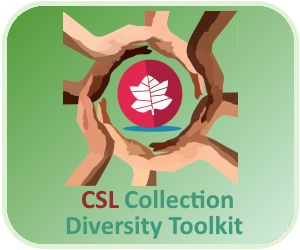 | 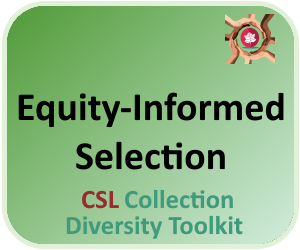 | 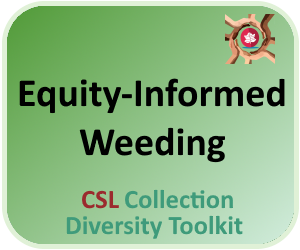 | 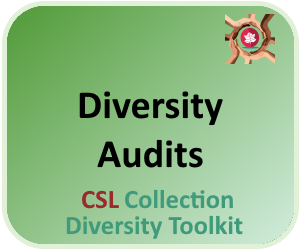 | 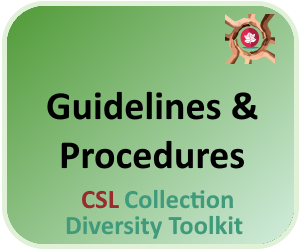 | 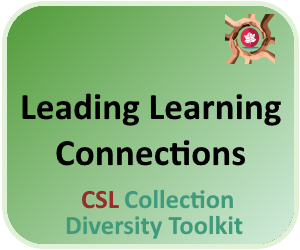 | 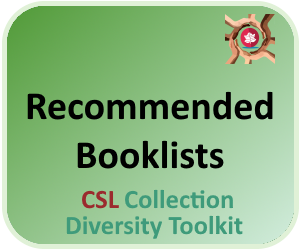 |

Equity-Informed Selection
Key Questions
- Why is it important to select resources through an equity lens?
- How is equity-informed selection based on the ethics and values of librarianship?
- What are the critical considerations for assessing resources?
- What does an equity-informed library collection look like?
- What strategies can we use to inform equitable selection?
The Ethical Foundations of Equity-Informed Selection
The ethical foundations of librarianship are based on advancing principles of democracy and human rights, by making information and learning accessible to all. Diverse collection development is a fundamental value of librarianship. Equity and inclusion are fundamental values in public education.
Equity-informed selection begins with guidelines that provide a mandate for selecting a wide range of diverse resources, and that defend librarians’ and educators’ responsibility to make selections based on sound criteria. Well-written guidelines defend universal principles of protecting intellectual freedom, and put collection diversity within the context of the rights and freedoms of all Canadians.
The first step in developing a plan for diversifying the library collection is to refer to your school district’s selection guidelines.
Strong selection criteria typical of Canadian school libraries mandate a collection that:
- Enriches the curriculum and engages readers
- Serves students’ varied interests, abilities, and learning styles
- Stimulates personal growth and the growth of critical thinking
- Provides a rich information environment to support inquiry
- Represents a variety of perspectives, including about controversial issues
- Promotes cross-curricular, holistic, and inquiry-based approaches to learning
Additionally, strong selection criteria emphasize the importance of representation in resource collections. The library collection should represent:
- The diversity of Canada’s religious, ethnic, and cultural groups and their contributions to our heritage
- Indigenous perspectives and ways of knowing
- Experiences and perspectives of individuals from diverse backgrounds, lifestyles, sexual orientation and gender identity or expression, and people of varying abilities
- Gender, cultural, and racial inclusiveness
These representations are protected and enshrined in the Canadian Charter of Rights and Freedoms and in provincial human rights codes. Resources cannot be rejected because they represent diverse peoples and communities. Trained library professionals make selections based on reason and principle rather than on personal opinion and bias. They also defend students’ right to resources that promote open inquiry, critical thinking, diversity in thought and expression, and respect for others.
Current Contexts for Equity-Informed Selection
Reflecting the larger context of our society, current professional discourse focuses prominently on equity and inclusion, cultural competence and anti-racism, and supporting diversity in all aspects of school library practice. School library activists are taking a critical look at diversity in collection development. They are dramatically shifting understandings of the library as a safe space, and being active, anti-racist educators. We understand that there is so much to be done.
Selecting Resources Through an Equity Lens
It is important that when we are selecting resources we use an informed equity lens and framework. The core foundational element of equity is to work towards fairness and justice for all through tangible actions. It is to recognize that historically and currently people of various identities have not been treated in a fair manner and that they require different things to succeed. We can ensure equity when we are selecting resources by centering on stories that show intersectional identities and experiences in all genres and categories, and looking carefully and critically at the content of the resources. In doing this, we are amplifying the voices of people and communities who have been and continue to be marginalized due to oppressive structures.
Library professionals have an important role to play and a responsibility in ensuring collections are of the highest quality and represent people authentically. Our collections must be relevant, responsive and current. All library staff can help connect teachers, students, and the entire school community to these resources through promotion and programming. Teacher-librarians can work with their colleagues to find ways to integrate all kinds of literature – fiction and picture books as well as non-fiction texts into content areas and instructional approaches, and can help make meaning through co-teaching.
“When we use children’s literature imbued with social justice values to engage students in critical discussions, it helps children to challenge taken-for-granted assumptions, as well as to think about others’ opinions and to consider why they may vary from their own. Pausing on a picture or passage during a read-aloud embraces the opportunity for reflection and encourages deeper conversations. It is a good way for educators to encourage and engage students to discuss their ideas and beliefs, and for students to listen intently to the ideas and opinions of others. When we embrace our role as agents for change, we seek to expose, critique, challenge, and transform the ideas and actions of those who are marginalized, working to provide equity and a voice and power to our students to make change.”
Larry Swartz (2020). Teaching Through Tough Topics: How do I use children’s literature to build a deeper understanding of social justice, equity, and diversity? Markham, ON: Pembroke Publishers
Critical Considerations for Assessing Resources
Whose voices are included?
Who is represented in the resource in terms of race, ethnicity, class, gender identity, and ability? Is this diversity represented in main characters, or relegated to minor or token roles? Are diverse characters represented in a one-dimensional way? Do character representations reflect the interconnected nature of social categorizations such as race, class, and gender, or are they one-dimensional? Can students see themselves reflected in what they read?
How accurate are representations of the diversity of experiences of the range of religious, ethnic, cultural groups, and individuals from diverse backgrounds, lifestyles, sexual orientation and gender identity or expression?
Does the story represent a range of experiences of groups represented, or does it focus on a deficit narrative about those groups? Does it reinforce or disrupt stereotypes? Are the diverse characters the heroes of the story, or the ones being “helped”? Are some groups represented only in stereotypical settings? Does the narrative and representations of characters and settings accurately reflect a deep knowledge of the people and communities represented in the story? Does the resource help break down or on the other hand help perpetuate negative stereotypes?
Does the resource reflect current contexts for understanding history, society and culture?
History doesn’t change, but perspectives on history change radically over time as more is uncovered and more voices are represented. Student inquiry should be informed by current perspectives. Are the cultural practices of Canada’s Indigenous peoples represented as historical anachronisms, or as part of lived, contemporary culture?
Who is writing and/or illustrating the story?
Do the voices of the writer and/or illustrator contribute the authenticity of the story? Research conducted by Deborah Dundas of The Toronto Star in 2019 indicated that diverse faces are being reflected more and more in children’s books in Canada, but the people telling the stories were still overwhelmingly white. Dundas conducted a similar survey in 2020, which found that other voices were increasing incrementally.
It is important that the stories be written in an authentic voice – a voice from the community being represented. Authenticity in writing comes when authors have a deep knowledge and understanding of what they are writing about: it is extremely important to select books written by those who are from diverse and/or marginalized backgrounds, telling their own stories.
An author who is not from that community, no matter how much research they do, may not be able to understand the nuances of that culture. These authors’ experiences may be biased or judgmental of other communities’ experiences (i.e. Muslim women wearing a hijab). This may cause hurt or harm, and may also promote false or incorrect narratives. Students want, need and deserve to read stories from authors who look like them and reflect their lived experiences authentically.
Whose voices are excluded?
How diverse is the library collection as a whole? Is information about diverse groups represented fully and accurately in the collection? Whose voices are excluded from the information in all formats in terms of stories, authors, and representations of characters and communities?
Are we ensuring equity of access for all?
The library collection should be organized to ensure rather than impede access. Whether or not you think students should be reading certain books, if they were selected according to the library’s selection criteria, it is unethical to restrict access.
Are we providing differentiated entry points to reading, inquiry, and learning?
The entry point to reading in the library is interest, not level. Are diverse characters and stories represented in all collections of the library, and at varying reading levels, or is age or grade level being used to prevent younger children from being exposed to diverse topics and characters?
Are we providing varying formats for varying abilities and contexts?
Reading and inquiry should be accessible to all. Library professionals should strive to include rich collections in diverse formats so that students with auditory or visual impairments have access to stories. Universal design for learning should frame our understanding of accessibility. While a different format may be necessary for some, it is good for all. Listening to an audiobook IS reading!
Another consideration is how individual resources are formatted. A resource that is too text-dense, lacks relevant illustrations with informative captions, and is otherwise difficult to navigate, impedes all students’ ability to make sense of information.
Are we checking our own perspectives and filters?
It is a professional ethical responsibility to make selections based on reason and principle rather than on personal opinion and bias. That in and of itself makes it clear that responsible collection development is diverse collection development.
Even the most ethical and responsible library professional must also acknowledge that our own identities and lived experiences may directly or indirectly influence the choices that we make. How do our own identities inform our work? Do we tend to focus on particular topics or genres based on our own cultural backgrounds? What might we tend to miss, marginalize, or omit? What are we doing to break down our own biases?
Are we striving to understand and involve the communities that we serve?
No matter what our personal preferences may be, we need to continually engage and connect with the students that we are trying to serve to ensure that our collections are meeting their needs and reflect their lived experiences from a variety of perspectives. No community group is a monolith. For most of us, social categorizations such as race, class, and gender are interwoven into our own identities, and this is true of our students. Selection of books from diverse communities is not enough. Our students need to see themselves reflected in what they read, with all of the complexities of their experiences and intersectionalities of their identities.
We need to look at what story is being told and how it is being told. For example, there should be stories that feature Black characters in love, going on adventures, or coming out. Collections shouldn’t only contain stories in which Black characters are shot and killed, live in poverty or are involved in gang activity. Although many of these stories are well-written, there should never be a single narrative being told.
Are we empowering student voice and choice?
Who understands contexts and communities better than our students themselves. As library professionals, we should try to find ways to involve students in selection of new resources, through request forms, surveys, and even taking them along on book shopping trips! Consider all of the ways that students can provide input and feedback leveraging technology. Most importantly, work on developing open and trusting relationships with students, teachers, and all members of the learning community, so that people are willing to express preferences and also concerns.
As library professionals,we have an ethical responsibility to make selections based on reason and principle rather than on personal opinion and bias. Being open to criticism and feedback from those we serve is part of this responsibility. We need to ensure that our spaces, collections and resources are evolving to meet the ever changing needs of those who are served by our libraries.
Useful Tools for Equitable Selection
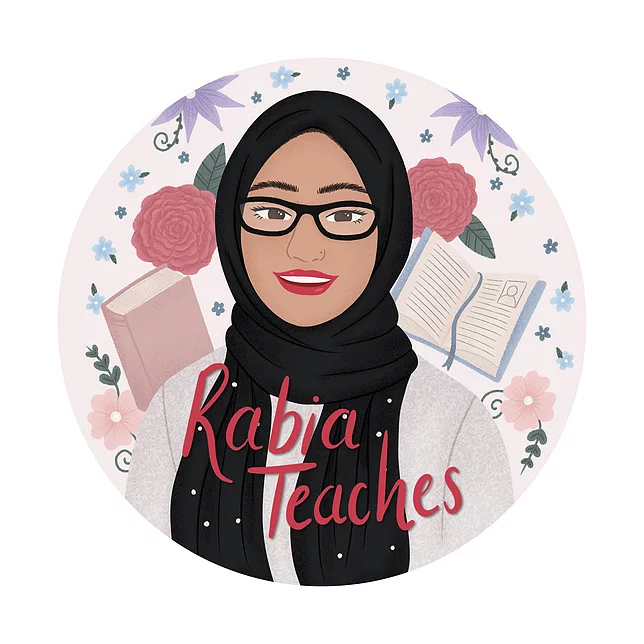
Rabia Khokhar: Toronto teacher and education consultant Rabia Khokhar shares anti-racist and equity-focused strategies, book recommendations and other resources on her website. Her Anti-Racism Checklist is a particularly useful tool for equity-informed selection, as a tool to help ensure that resource selection is free from racial assumptions and stereotypes.
Teaching Tolerance: Reading Diversity Lite: A Tool for Selecting Diverse Texts. Learning for Justice provides this useful and concise checklist to enhance reading diversity.
Be sure to visit the Recommended Booklists page for links to a wealth of suggestions for resources, as well as links to book vendors who specialize in diversity.
Digging Deeper: Additional Resources
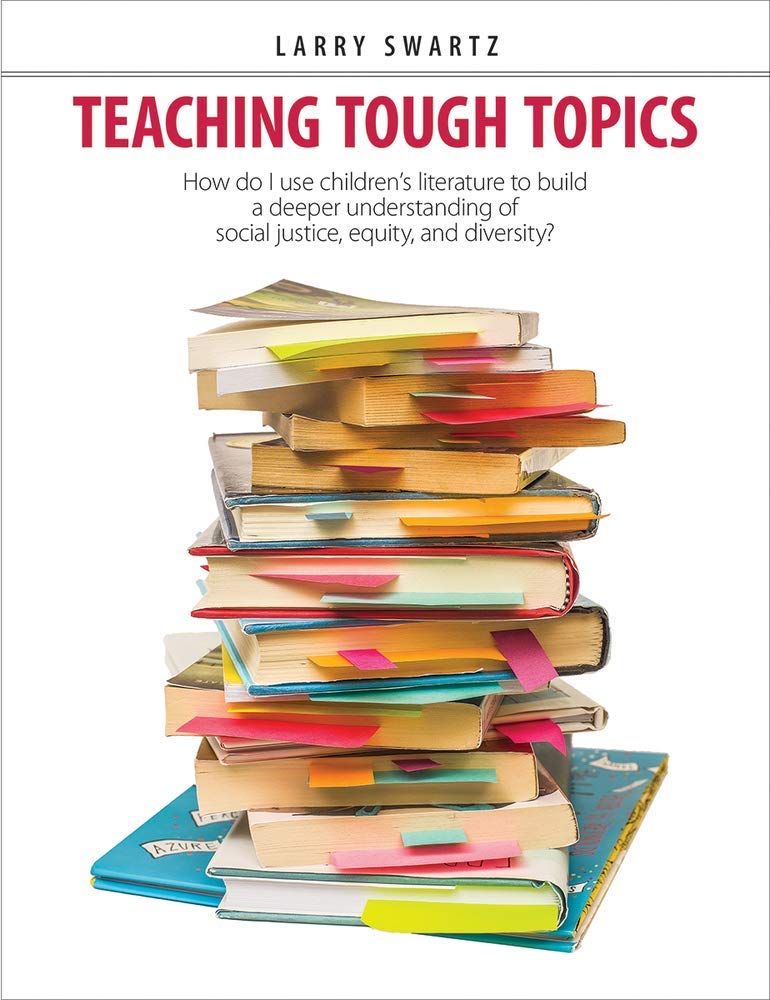
Larry Swartz (2020). Teaching Through Tough Topics: How do I use children’s literature to build a deeper understanding of social justice, equity, and diversity? Markham, ON: Pembroke Publishers
Canadian education scholar and literacy specialist Larry Swartz provides a comprehensive guide to choosing and using the best children’s books to address sensitive but significant topics in the classroom. It focuses on helping students develop a better understanding of social justice, diversity, and equity through culturally responsive teaching practices and literature-based programming. Highly recommended.
Websites:
Diverse BookFinder: A comprehensive collection of children’s picture books featuring Black and Indigenous people and People of Color (BIPOC). Recipient of the American Association of School Librarians’ 2021 Best Digital Tool award.
DIG Checklist for Inclusive, High-Quality Children’s Media: A checklist designed to help identify and recognize high-quality, inclusive children’s digital media.
Selecting and Using Culturally Responsive Children’s Books: A publication of the OHS National Center on Cultural & Linguistic Responsiveness, USA. No date.
We Need Diverse Books: An American non-profit and a grassroots organization of children’s book lovers that advocates essential changes in the publishing industry to produce and promote literature that reflects and honours the lives of all young people.
Articles:
Derman-Sparks, Louise (2016). Guide for Selecting Anti-Bias Children’s Books. Social Justice Books.
Koerster, Amy (2015). Selection is a Privilege. The Show Me Librarian.
LaGarde, Jennifer (2019). From Student Voice to Student Agency: Creating Library Spaces For Kids By Kids. The Adventures of Library Girl!
Newhouse, Kara (2020). Diversifying Your Classroom Book Collections? Avoid these 7 Pitfalls. KQED MindShift.
Plemmons, Andy (2016). Power of Student Voice. School Library Connection.
Plemmons, Andy (2017). Empowering Student Voice in the Library. ALSC Blog.
Sport, M. & Phipps Soeiro, L. (2018). Evaluating a Collection for Bias and Stereotypes with Primary Students: A Case Study, Tools, and Tips. School Library Journal.
 |  |  |  | ||
 |  |  |
